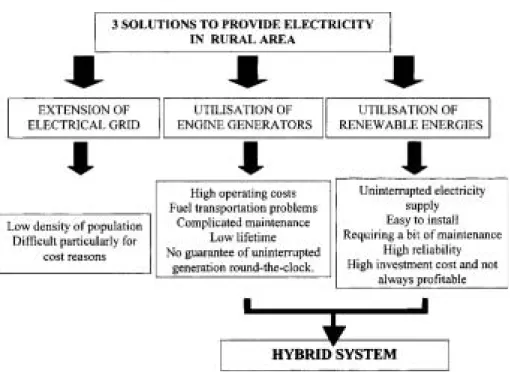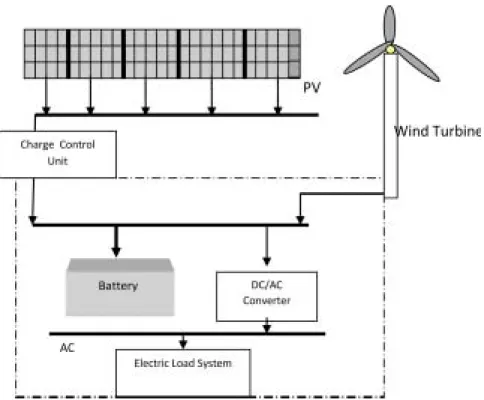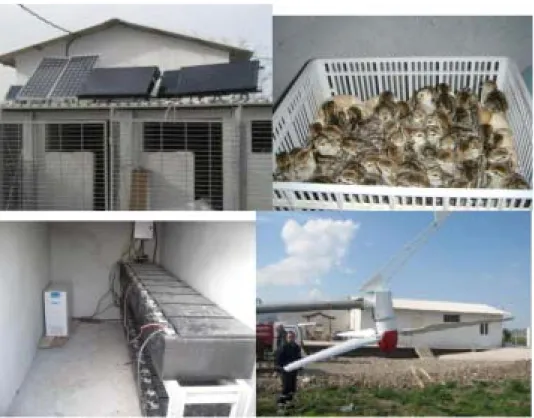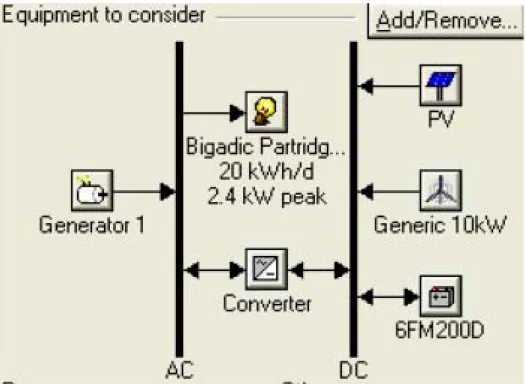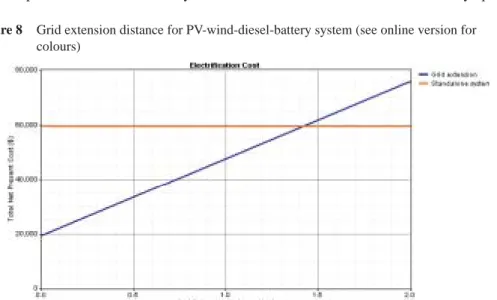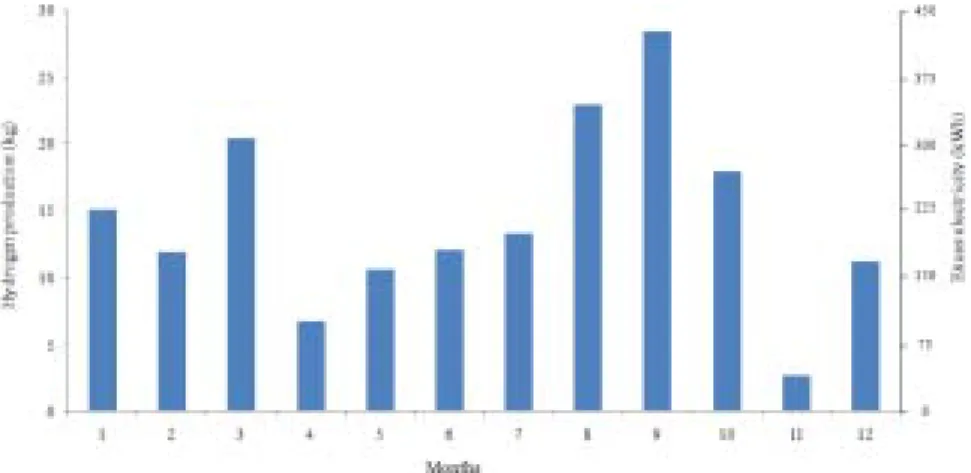A case study of hybrid wind-solar power system for reduction of CO<SUB
align="right">2 emissions
Article in International Journal of Global Warming · June 2012 DOI: 10.1504/IJGW.2012.047284 CITATIONS 3 READS 132 3 authors, including:
Some of the authors of this publication are also working on these related projects:
Elektromekanik Sektörü İçin Çok Amaçlı CNC Kontrollü Yeni Bir Dik İşlem Merkezi Otomasyonu, Tasarımı Ve Prototip İmalatıView project
Photocatalytic reactor for Cu-Cl cycleView project Ersin Akyuz
Balikesir University
17PUBLICATIONS 152CITATIONS
SEE PROFILE
Ibrahim Dincer
University of Ontario Institute of Technology 1,267PUBLICATIONS 33,507CITATIONS
SEE PROFILE
All content following this page was uploaded by Ersin Akyuz on 12 January 2016.
Copyright © 2012 Inderscience Enterprises Ltd.
A case study of hybrid wind-solar power system for
reduction of CO
2emissions
Ersin Akyuz and Zuhal Oktay*
Faculty of Engineering,
Mechanical Engineering Department, Balikesir University, 10110 Balikesir, Turkey E-mail: eakyuz@balikesir.edu.tr E-mail: zuhal.oktay@gmail.com *Corresponding author
Ibrahim Dincer
Faculty of Engineering and Applied Science,
University of Ontario Institute of Technology (UOIT), 2000 Simcoe St. N., Oshawa, ON L1H 7K4, Canada E-mail: ibrahim.dincer@uoit.ca
Abstract: In this study, the solar radiation and wind data pertaining to Bigadic region
are analyzed to assess the performance of a hybrid Photovoltaic–Wind–Diesel– Battery energy system. The average energy consumption of the system is about 20.33 kWh per day and 600 kWh per month, with a peak power demand of 2.4 kW. A 10 kW Wind Turbine and a 1 kWp PV energy system with 48 kW battery are installed. The emissions and energy costs are calculated and compared with the diesel-only and hybrid system. A break-even analysis is conducted for the hybrid system, which turned out to equal 1.44 km.
Keywords: sustainability; PV–wind–diesel–battery; hybrid system; environment;
energy; effi ciency.
Reference to this paper should be made as follows: Akyuz, E., Oktay, Z. and
Dincer, I. (2012) ‘A case study of hybrid wind-solar power system for reduction of
CO2 emissions’, Int. J. Global Warming, Vol. 4, No. 1, pp.52–67.
Biographical notes: Ersin Akyuz received his BSc in Electrical Engineering
from Istanbul Technical University, Turkey. He did his MSc and PhD in Gazi University and Balikesir University, respectively. He worked on many projects such as Leonardo Mobility and GEF-UNDP. Currently, he works as a Lecturer in vocational high school. His research interests are energy conversion systems, power plants and Renewable Energy systems.
Zuhal Oktay received her BSc in Mechanical Engineering from Uludag University, Turkey. In 1999, she did her PhD in the Department of Mechanical Engineering at Balikesir University and currently works there as an Associate Professor. She was a Postdoctoral Fellow at the University of Ontario Institute of Technology in
Canada in 2007. Her research interests are energy conversion systems, alternative energy sources, power plants, geothermal district heating systems, Renewable Energy systems and exergy analysis.
Ibrahim Dincer is a Full Professor in the Faculty of Engineering and Applied Sciences at UOIT. Renowned for his pioneering works, he has Authored and Co-authored many books and book chapters, refereed journals and conference papers and technical reports. He has chaired many national and international conferences, symposia, workshops and technical meetings. He is an Active Member of various international scientifi c organisations and societies, and serves as Editor-in-Chief, Associate Editor, Regional Editor and Editorial Board Member in various prestigious international journals. He is a recipient of several research, teaching and service awards, including the Premier’s research excellence award in 2004.
1 Introduction
It is strongly believed in scientifi c communities that the greenhouse gas emissions caused by fossil-fuel-based energy sources contribute to global warming and hence climate change. Budzianowski (2011a) proposed a modelling analysis of dynamical behaviour of global warming and presents climatic hysteresis diagrams. He expresses that current thermal imbalance of Earth is more likely to amount 0.6 K but it can increase to 5 K by 2100. Thus, implementing sustainable energy strategies for creating a sustainable living space is important for combating the climate change and global warming issues. Future energy strategy should place a greater emphasis on the development of potential energy sources, which should constitute the framework of the global energy structure in the future. The agricultural industry’s role as a consumer of energy is well known. Energy production from farm-based bio-fuels and the wind-PV generation grew rapidly in recent years, but such alternative energy sources still remain negligible relative to the total national energy needs (Budzianowski, 2012; El Bassam, 1998; Budzianowski, 2011b). Having access to a reliable and continuous electric network is also very important for animal breeders. For instance, it is required to use extra power generation equipment in rural places, where connection to the electricity grid is present, owing to the frequent power shutdowns and transmission problems (Rosenthal, 1999).
The sizable costs of grid extension into rural areas often lead various researchers to explore alternative solutions (as shown in Figure 1). The choice of diesel generation has been regarded for a long time as the most viable economical and reliable alternative, but this solution is not always the most profi table option and also induces several environmental and practical problems for the user such as high operating costs, relatively low effi ciency and fi nally noise nuisance (Notton et al., 2001).
In the open literature, one of the very fi rst studies was conducted by Byrne et al. (2005) on the potential of solar electric applications for the Delaware’s poultry farms in April 2005 and on the feasibility of PV systems used in the same farms. The researchers carried out a feasibility study using a simulation model approach and testing alternative scenarios and cost conditions. Their study showed that solar energy is economical for the state’s producers under a certain set of policy incentives.
Ernest and Brown (2009) analysed broiler production in fi ve different regions in Tennessee, which accounted for about 46% of total production in the state. They investigated not only the economic feasibility of solar PV energy generation, but also the impact of alternative energy programmes and the other factors on several solar regions within Tennessee’s poultry industry.
Akyuz et al. (2009) investigated the global solar radiation potential of Balikesir in Turkey and performed an analysis to assess the techno-economic viability and environmental performance of a hybrid PV-diesel-battery system to meet the load requirements of a typical rural farmhouse. The Cost of Energy (CoE) for this kind of hybrid system was found to be 1.245 US$/kWh.
In an another study, Akyuz et al. (2011a) also evaluated the cost, environmental advantages and benefi ts of the Demand-Side Management (DSM) in case the renewable hybrid energy options were applied to poultry farming. For RE systems, DSM approach proved to be benefi cial.
Various studies indicated that hybrid renewable electrical systems in off-grid applications are economically viable, especially in remote locations. Studies on the scaling of RE systems performed their analyses with the HOMER software (Shaahid and Elhadidy, 2007; Shaahid and El-Amin, 2009; Himri et al., 2008; Dalton et al., 2008; Wies et al., 2005). The performance of hybrid RE systems changes with respect to the input parameters, such as the wind speed, global solar radiation, temperature and geographic location. Appropriate scaling of system components is essential with respect to supplying the necessary energy for the load demand of off-grid systems. Sizes and capacities of components used in RE system vary depending on the geographic location, energy sources and load demand.
Figure 1 Alternative solutions for rural electrifi cation
Sustainable energy strategies, such as hydrogen energy and hydrogen production from RE sources, are very crucial for the solution of climate change and global warming problems and for creating a sustainable living space. To date, many scientists focused on the scaling and system performances of hybrid RE systems based on the production of hydrogen, mainly concentrating on solar and wind energy options (Zoulias and Lymberopoulos, 2007; Beccali et al., 2008; Mills and Al-Hallaj, 2004; Cotrell and Pratt, 2003; Akyuz et al., 2011b).
Vosen and Keller (1999) proposed the economic optimisation of PV systems by combining them with energy storage equipment, hence using both batteries and hydrogen. The best economic results were obtained when both of the energy storage systems were utilised simultaneously, namely hydrogen and batteries.
Kamaruzzaman et al. (2009) investigated and tested hydrogen production from the excess energy located in long-term energy storage components of RE applications. The excess energy produced, with respect to the load requirement, is transferred to the electrolyser for hydrogen production. A control algorithm is then developed to control both the autonomous operation and energy management of the system. The combination of a battery bank with long-term energy storage can signifi cantly improve the performance results of RE systems.
In this study, production of electrical energy from solar and wind energy sources as well as hydrogen production from the excess electricity generated is comprehensively studied. First, the optimal scales of the RE system elements are determined by projecting the annual energy need of the facility and the local meteorological data. The HOMER software is used to determine the sizes of systems elements. Then, a hybrid energy system is set up in a partridge facility to investigate the economical and environmental aspects.
2 System description
The Bigadic partridge facility was built in Bigadic, in 2009, for the purpose of raising chucker partridges and preserving the specie’s population in the region. Initially, it became operational with the objective of attaining ‘Sustainable Wild Life in Alacam Mountains’, and ‘creating an exemplary living space that combats against climate change and preserves the existing natural diversity’. Then, it was considered that the system’s energy demand can be supplied by using RE sources, which would also set a precedent for similar animal feeding facilities. These applications could be benefi cial for attaining a sustainable environment. Furthermore, such plans can be introduced to the students and people as an Exemplary School of Nature by means of RE Sources. On account of these reasons, it was aimed to meet the energy demand of the facility through RE alternatives. Finally, this facility received fi nancial support from Global Environment Facility-Small Grants Program.
Energy plays an important role in partridge production. As it is extensively used for the operation of heating system, pumps, ventilation, lightening and brooders, Bigadic PF assessed its energy needs to estimate the overall electricity demand. All electrical equipments being used in the facility and their power usage are given in Table 1. The PF is projected to have an average energy consumption of about 20.33 kWh per day, with a peak demand of 2.4 kW. The daily load demand is given in Figure 2.
2.1 Description of the hybrid energy system
The hybrid RE system confi guration is described in Figure 3. This system uses two complementary energy sources: a principal source, the wind energy, converted into electrical energy via a Wind Turbine (WT). PV cells produce direct current electricity from light and Figure 3 The Bigadic hybrid renewable energy system (see online version for colours)
Table 1 Electrical equipment of the PF
Equipments Numbers Power (W) Total Power (W)
Brooder 2 750 1500
Refrigerator 1 250 250
Inside lighting 3 36 108
Outside lighting 7 36 252
Total 2610
third source; diesel generator converted mechanical power to AC electrical power via an engine generator. The battery is used as a storage system and as a buffer between input powers. The electrical power produced by the WT and PV supplies the load, and if this power is not suffi cient, the complementary power comes from the battery or from the diesel generator if the battery cannot supply it. In conjunction with this, Figure 4 shows the structure of the hybrid system.
Figure 4 Installation of RE system in Bigadic PF (see online version for colours)
2.2 Methodology for data collection
Bigadic is situated on the land about 30 km away from Balikesir airport. In the simulations, the actual data on the hourly global solar radiations and average hourly wind speed were collected from Balikesir Airport. These data are measured by an Automatic Weather Station. Accuracy of the data obtained was checked and deemed to be acceptable for reliability of the analysis.
In the simulations, the actual data on the hourly global solar radiations on tilted plane (39°) for 2003 and average hourly wind speed were collected from Balikesir Airport and employed for the computations. Monthly global solar radiation data and average wind speed are presented in Table 2. Global solar radiation level is higher in the summer months. The monthly global solar radiation values, between December and July, range from 1.8 to 7.49 kWh per m2
. The annual average daily solar global radiation level is found as 4.48 kWh per m2
. The monthly average wind speed at a height of 10 m varies from 1.84 to 6.43 m/s.
January February Mar ch April May June July August September October November December Radiation (kWh/m 2 ) 2.07 2.82 3.98 5.30 6.37 7.32 7.49 6.75 5.54 3.56 2.28 1.80 W ind speed (m/s) 3.49 3.61 4.91 3.09 3.56 3.77 4.23 5.57 6.43 4.63 1.84 3.17
3 Analysis and simulation
In this study, the HOMER simulation software (HOMER, www.nrel.gov/homer) is used to assess their techno-economic viability and to sizing of RE system. The HOMER was originally developed by the National Renewable Energy Laboratory (NREL) as a potential simulation and optimisation tool for RE systems. The HOMER performs three principal tasks: simulation, optimisation and sensitivity analysis. In the simulation process, the HOMER models the performance of a particular micropower system confi guration each hour of the year to determine its technical feasibility and life-cycle cost. In the optimisation process, the HOMER simulates many different system confi gurations in search of the one that satisfi es the technical constraints at the lowest life-cycle cost.
The simulation scheme of HOMER software concerning the PV-wind-diesel-battery system is shown in Figure 5. The HOMER’s optimisation and sensitivity analysis algorithms make it easier to evaluate many possible system confi gurations. The optimal economic designs of PV or wind or diesel systems can be achieved with energy storage in batteries. Usually, the optimal design is carried out minimising the Net Present Cost (NPC) (NPC: investment costs plus the discounted present value of all future operational costs during the lifetime of the system).
Figure 5 HOMER simulation scheme for the PV-wind-diesel-battery system (see online version
for colours)
3.1 Life Cycle Costing analysis
The Life Cycle Costing (LCC) analysis is a tool used to compare the ultimate delivered costs of technologies with different cost structures. Rather than comparing only the initial capital
costs or operating costs, LCC analysis seeks to calculate the cost of delivering a service over the life of the project. The fi nal cost per kWh is estimated independent of the technology used to deliver the electricity. The CoE can be explained with Total Present Value (TPV), and Annual Load (AL), as follows (Karki and Billinton, 2001; Lazou and Papatsoris, 2000; Setiawan et al., 2009):
TPV=Initial cost +
∑
O and M+∑
Replacement +∑
Fuel cost. (1)The levelised energy cost (US$/kWh) can be found from
TPV CRF
LEC
AL ×
= (2)
where CRF is the capital recovery factor and defi ned as
(1 ) CRF (1 ) 1 N N R R R + ⋅ = + − (3)
where R is of 8% the net discount rate and N is of 25 the economic evaluation period. Table 3 gives the price of equipments for the hybrid RE system.
Table 3 Technical properties and unit price of the equipments for the hybrid RE system
Units Values Units Values
PV Diesel generator units
Capital (US$/kWp) 7500 Replacement (US$) 500
Life time (yr) 25 Capital cost (US$/kW) 500
Operation and maintenance (US$/yr)
0 Operation and
maintenance (US$/h)
0.15
Tilt angle PV modules Lat: 39°
Replacement (US$) 6500 Batteries
Wind Type of batteries Lead-acid
Capacity (kW) 10 Nominal voltage (V) 12
Capital cost (US$) 10000 Nominal capacity 200 Ah
Nominal electrical output (kW) 10 Capital cost (US$) 200
Replacement (US$) 9000
Operation and maintenance (US$/yr)
50 Inverter
Life time (yr) 25 Nominal output (kW) 5
Capital (US$/kW) 400
3.2 Break-even analysis
At this stage, a break-even distance analysis is performed for each autonomous hybrid energy system with respect to the required transmission line extension. In other words, this analysis determines how far the site of the alternative energy system should be from the closest existing utility line so that the system is cost effective (breaks even) when compared with using a conventional transmission line. For the cost analysis, the Net Present Value (NPV) method is used. The total cost obviously changes according to the length of the transmission line and equals to sum of the operating costs and the investment cost (Ekren
et al., 2009). Operational costs of the grid system are the electricity consumption fee and the maintenance costs. Total cost of extension has two parameters: the fi xed cost and variable cost. Fixed costs are assumed to be composed of the respective components; Pile (2790 kg), a distributor transformer: (31.5 kV, 20 kVA), a PL-250 transformer platform: (500 kg), current transformer: (50/5 A), OG fuses: (36 kV, 2–20), fuse separator: (36 kV– 630 A), ground separator (36 kV–630 A), power panel, electric meter (220/380), and fi nally a circuit breaker (3 * 80 A compact). Variable cost comprises pile installation, pile transportation, wiring (110 kg/km) and pile 8–12 (2170 kg). The capital cost per kilometre was calculated as US$ 20,000, while the O and M cost was found to be 300 $/km/year and the price of electricity from the power grid was taken as 0.17 US$/kWh. Total cost of extension can be defi ned as:
Ex,T i op
C =C +C (4)
where CEx,T, Ci and Cop represent the total cost of extension, initial cost and operation cost,
respectively. The total operation cost of the extended transmission line is given by op,T M,T E,T
C =C +C (5)
where Cop,T, CM,T and CE,T represent total operation cost, total maintenance cost and total
electric cost, respectively. Life cycle cost of RE system may include capital costs, replacement costs, operating and maintenance costs and fuel costs.
3.3 Environmental impact
The air polluting emissions CO2, NOx and particulate matters are evaluated in terms of the
per kilowatt-hour electrical energy consumption for different cases. The emission factors used in HOMER simulation are given in Table 4.
Table 4 Reference emission factors for diesel fuel
Pollutant Unit Value
Carbon dioxide Kg/L of fuel 2.64
Carbon monoxide g/L of fuel 6.5
Unburned hydrocarbons g/L of fuel 0.72
Particulate matter g/L of fuel 0.49
Proportion of fuel sulphur converted to PM % 2.2
Nitrogen oxides g/L of fuel 58
The amount of pollutant emissions was calculated and compared against the diesel-only option. The annual pollutant emissions are listed in Table 5. The diesel-only electricity generation depends entirely on fossil fuels. Thus, the amount of fuel usage and its negative environmental impact is high. The diesel-only system produced 13,353 kWh electric energy besides emitting 18,370 kg of CO2, 3.2 kg of PM and 405 kg of NOx in a year’s time as a
result of burning diesel. Replacing the diesel only system with a 1 kW PV array and a 10 kW WT, the greenhouse gas emissions were reduced for CO2 to 2699 kg, PM to 0.5 kg and NOx
Table 5 Comparison for diesel-only and hybrid options for pollutant emissions
Diesel-only Hybrid option
Pollutant Emissions (kg/yr) Emissions (kg/yr)
Carbon dioxide 18,370 2,699 Carbon monoxide 45.3 6.66 Unburned hydrocarbons 5.02 0.738 Particulate matter 3.42 0.502 Sulphur dioxide 36.9 5.42 Nitrogen oxides 405 59.5
4 Results and discussion
In this study, the feasibility of an RE system was determined with respect to installing a hybrid energy system at a Bigadic PF. The solar radiation data and wind data of Bigadic region were analysed to assess the performance of hybrid energy options that would suffi ce to meet the load requirements of the PF. Operational performance characteristics, namely the annual electrical energy production and the excess electricity generation, were calculated. Also, the environmental impact parameters of the system, such as carbon emissions and the annual diesel consumption, were calculated. Moreover, life-cycle cost analyses of each hybrid option were also conducted.
The monthly electricity production of PV-wind-diesel-battery energy system was determined. As we can see in Figure 6, electric energy production of the system mainly depends on resources and the electric load. During the summer months, electricity production increases as a virtue of the rising levels of wind speed and global solar radiation. On the other hand, although the resources and energy production increases during the summer months, the system still necessitates diesel electric generation because of the higher energy demand of the PF during the same season.
Figure 6 Monthly electrical production of PV-wind-diesel-battery system (see online version
for colours)
In Figure 7, the diesel-only and the hybrid systems (PV-diesel-battery and wind-diesel-battery) are compared with each other. Initial costs for these systems are estimated as $24,000, $17,000 and $2000 for PV-wind-diesel-battery, wind-diesel-battery and diesel-only system, respectively. The total operating hours per annum for the generator
types are found as 602 for PV-Wind-Diesel-Battery, 759 for Wind-Diesel-Battery and 8760 for diesel-only system. The annual operating costs of these systems are $3313, $4868 and $22,328, respectively. RE fractions for the PV-Wind-Diesel-Battery, Wind-Diesel-Battery and diesel-only system are 0.88, 0.84 and 0, respectively. As can be inferred from these fi gures, the PV-Wind-Diesel-Battery system is the best energy option, since the CoE is lowest (0.762 US$/kWh) when compared with other options. The rate of fuel consumption for the hybrid system is 1007 L/yr. Because of the low fuel consumption rate, the level of greenhouse gas emissions (CO2, PM, NOx) released into the atmosphere is much lower as well.
Figure 7 Determination of the optimal system confi gurations (see online version for colours)
In addition, break-even analysis was performed to decide the optimum distance where the hybrid energy system is more economical than the extension of the transmission line. It is seen from Figure 8 that distances greater than 1.44 km result in economical advantage in favour of the PV-wind-diesel-battery option in comparison with the other options. Simple payback period for this option was found to be 1.73 years, which is shorter than that of the diesel-only option. Figure 8 Grid extension distance for PV-wind-diesel-battery system (see online version for
colours)
The excess electricity generation arises after the batteries are full. The excess energy may be used to generate hydrogen by electrolysis, which can then be economically stored for later production of electricity in fuel cells.
To analyse the potential amount of hydrogen production from the excess electricity, the quantities of power surplus have to be estimated. In this sense, ‘the excess electricity’ will be defi ned as the portion of electricity, which cannot be utilised inside the facility in times of high generation and low demand. During such periods, the renewable generation will have to be halted to assure grid stability. The excess energy values for Diesel-Battery and Wind-PV-Diesel-Battery systems were estimated as 14,957 kW/yr and 14,131 kW/yr, respectively.
The monthly excess electricity and hydrogen production potentials of this system are shown in Figure 9. Here, the produced hydrogen could be used as a fuel to feed an energy conversion device, which would act as a secondary power source in periods of high demand. The RE sources at Bigadic PF are a WT capable of generating a maximum electrical power of 10 kW and PV cells of 1 kWp. The hydrogen produced is initially stored in a pressurised tank, which is then fed to a 1 kW proton exchange membrane fuel cell unit for conversion into electricity when needed.
Figure 9 Hydrogen production potential from excess electricity (see online version for colours)
The simulation results for Wind–Diesel–Battery system were selected to test the reliability/ validity of HOMER program. The output power of WT is fi tted with a 6th degree polynomial curve and the wind output power is calculated with an MS Excel program using hourly (8760-h) wind speed data. For economical calculations, the electricity unit prices, economic lifetimes (25-years) and the discount rates of components used in the simulation were likewise taken into consideration to calculate the annualised costs. Reliability of the program results is shown in Table 6.
Table 6 Comparison of the Homer results with the fi ndings for wind-diesel-battery system
HOMER simulation results Present fi ndings
Generator output (kW) 3785 3902 Wind output (kW)) 19801 20414 Generator fuel (L) 1285 1324 Annual cost ($) 5661 5836 CoE ($/kW) 0.78 0.80 Difference 3.38% 5 Conclusions
This study has investigated a renewable hybrid power generation system, which was built in Bigadic, Turkey. The feasibility and scaling of this RE system are studied regarding the
installation of a hybrid energy system in Bigadic partridge raising facility. The main fi ndings of the study are summarised as follows:
• The PV-wind-diesel-battery system is found to be an optimal energy generation method compared with other hybrid options in terms of CoE.
• The LCC of energy option for PV-Wind-Diesel-Battery system is found to be 0.762 US$/ kWh.
• A simple payback time for the hybrid system is calculated as 1.73 years, which is economically favourable when compared with the generation cost of diesel-only options. • The distance less than 1.44 km from the closest power grid comes out the PV-wind-diesel-battery system as the more economical option instead of supplying power from the external grid. It is clear that the results are strongly dependent on the wind and solar condition for the region.
• The annual hydrogen production potential from excess electricity is calculated as 180 kg for the PV-wind-diesel-battery system.
• 15.67 tons of CO2 and 346 kg NOx emissions are expected to be reduced as a result of
replacing the diesel-only system with the hybrid system. Acknowledgement
The authors acknowledge the support provided by Global Environment Facility-Small Grant Project (GEF-SGP) of United Nations Development Program (UNDP).
References
Akyuz, E., Oktay, Z. and Dincer, I. (2009) ‘The techno-economic and environmental aspects of a hybrid PV-diesel-battery power system for remote farm houses’, International Journal of Global
Warming, Vols. 1–3, pp.392–404.
Akyuz, E., Coskun, C., Oktay, Z. and Dincer, I. (2011a) ‘Hydrogen production probability distributions for a PV-electrolyser system’, International Journal of Hydrogen Energy, Vol. 36, No. 17, pp.11292–11299.
Akyuz, E., Oktay, Z. and Dincer, I. (2011b) ‘Energetic, environmental and economic aspects of a hybrid renewable energy system: a case study’, International Journal of Low-Carbon Technologies, Vol. 6, No. 1, pp.44–54.
Beccali, M., Brunone, S., Cellura, M. and Franzitta, V. (2008) ‘Energy, economic and environmental analysis on RET-hydrogen systems in residential buildings’, Renewable Energy, Vol. 33, No. 3, pp.366–382.
Budzianowski, W.M. (2011a) ‘Time delay of global warming’, International Journal of Global
Warming, Vol. 3, No.3, pp.289–306.
Budzianowski, W.M. (2011b) ‘Can ‘negative net CO2 emissions’ from decarbonised
biogas-to-electricity contribute to solving Poland’s carbon capture and sequestration dilemmas?’, Energy, Vol. 36, No. 11, pp.6318–6325.
Budzianowski, W.M. (2012) ‘Sustainable biogas energy in Poland: prospects and challenges’,
Renewable and Sustainable Energy Reviews, Vol. 16, pp.342–349.
Byrne, J., Glover, L. and Hegedus, S. (2005) The Potential of Solar Electric Applications for Delaware’s
Poultry Farms, Working Paper, Center for Energy and Environmental Policy, University of
Cotrell, J. and Pratt, W. (2003) ‘Modeling the feasibility of using fuel cells and hydrogen internal combustion engines in remote renewable energy systems’, in Proceedings of Wind Power, Austin, Texas, pp.1–15.
Dalton, G.J., Lockington, D.A. and Baldock, T.E. (2008) ‘Feasibility analysis of stand-alone renewable energy supply options for a large hotel’, Renewable Energy, Vol. 33, No. 7, pp.1475–1490. Ekren, O., Ekren, B. and Ozerdem, B. (2009) ‘Break-even analysis and size optimization of a PV/
wind hybrid energy conversion system with battery storage–a case study’, Applied Energy, Vol. 86, pp.1043–1054.
El Bassam, N. (1998) ‘Biological life support system sunder controlled environments’, in N. El Bassam, P. K. Behl, B. Prochnow. (Eds.): Sustainable Agriculture for Food, Energy and Industry, James James Science Publishers, London, Vol. 2, pp.1214–1216.
Ernest, F.B. and Brown, M.A. (2009) ‘Feasibility of solar technology (photovoltaic) adoption: a case study on Tennessee’s poultry industry’, Renewable Energy, Vol. 34, pp.748–754.
Himri, Y., Boudghene, S.A., Draoui, B. and Himri, S. (2008) ‘Techno-economical study of hybrid power system for a remote village in Algeria’, Energy, Vol. 33, No. 7, pp.1128–1136.
HOMER V.2 National Renewable Energy Laboratory (NREL), URL: http://www.nrel.gov/homer/ (reached March, 2011).
Kamaruzzaman, S., Mohd, Z.I., Wan, R.W.D., Mohd, Y.O., Baharuddin, Y. and Nowshad, A. (2009) ‘Performance of a PV–wind hybrid system for hydrogen production’, Renewable Energy, Vol. 34, pp.1973–1978.
Karki, R. and Billinton, R. (2001) ‘Reliability/cost implications of PV and wind energy utilization in small isolated power systems’, Energy Conversion IEEE Transactions, Vol. 16, pp.368–373. Lazou, A.A. and Papatsoris, A.D. (2000) ‘Economics of photovoltaic stand-alone residential
households: a case study for various European and mediterranean locations’, Solar Energy Solar
Cells, Vol. 62, pp.411–427.
Mills, A. and Al-Hallaj, S. (2004) ‘Simulation of hydrogen-based hybrid systems using hybrid2’,
Int. J. Hydrogen Energy, Vol. 29, No. 10, pp.991–999.
Notton, G., Cristofari, C., Poggi, P. and Muselli, M. (2001) ‘Wind hybrid electrical supply system: behavior simulation and sizing optimization’, Wind Energy, Vol. 4, No. 2, pp.43–59.
Rosenthal, A.L. (1999) ‘Evaluation of hybrid power system alternatives: a case study’, Prog. Photovolt:
Res. Appl., Vol. 7, pp.183–190.
Setiawan, A.A., Zhao, Y.C. and Nayar, V. (2009) ‘Design, economic analysis and environmental considerations of mini-grid hybrid power system with reverse osmosis desalination plant for remote areas’, Renewable Energy, Vol. 34, pp.374–383.
Shaahid, S.M. and El-Amin, I. (2009) ‘Techno-economic evaluation of off-grid hybrid photovoltaic– diesel–battery power systems for rural electrification in Saudi Arabia – a way forward for sustainable development’, Renew. Sustain Energy Rev., Vol. 13, pp.625–633.
Shaahid, S.M. and Elhadidy, M.A. (2007) ‘Technical and economic assessment of grid-independent hybrid photovoltaic–diesel–battery power systems for commercial loads in desert environments’,
Renewable Sustainable Energy Rev., Vol. 11, No. 8, pp.1794–1810.
Vosen, S.R. and Keller, J.O. (1999) ‘Hybrid energy storage systems for stand-alone electric power systems: optimization of systems performance and cost through control strategies’, Int. J.
Hydrogen Energy, Vol. 24, No. 12, pp.1139–1156.
Wies, R.W., Johnson, R.A., Agrawal, A.N. and Chubb, T.J. (2005) ‘Simulink model for economic analysis and environmental impacts of a PV with Diesel–Battery system for remote villages’,
IEEE Trans Power Systems, Vol. 20, No. 2, pp.692–700.
Zoulias, E.I. and Lymberopoulos, N. (2007) ‘Techno-economic analysis of the integration of hydrogen energy technologies in renewable energy-based stand-alone power systems’, Renewable Energy, Vol. 32, No. 4, pp.680–696.
Nomenclature
AL Annual Load (kWh)
C Cost (US$)
CoE Cost of energy (US$/kWh)
CRF Capital Recovery Factor (–)
kWp Peak power
LEC Levelised Energy Cost (US$/kWh)
N Economic evaluation period (year)
R Net discount rate (%)
TPV Total Present Value (US$)
Subscripts
E, T Total electric
Ex, T Total extension
in Initial
M, T Total maintenance
op Operation
op, T Total operation
Abbreviations
GEF Global Environment Facility
O and M Operation and Maintenance
PF Partridge Facility
RE Renewable Energy
UNDP United Nations Development Program
View publication stats View publication stats
